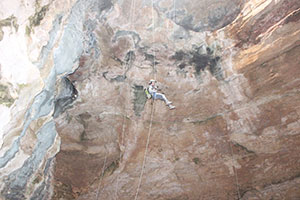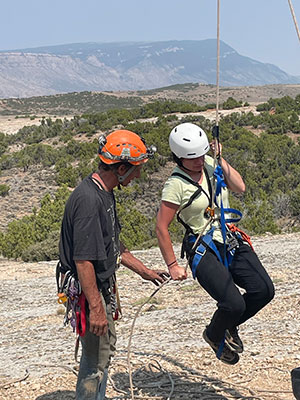UW Researcher Collects Sediment from Natural Trap Cave to Study Past Climate Conditions
Published August 06, 2021

Much like an ancient bighorn sheep or a woolly mammoth from the Pleistocene era, Ioana Stefanescu stood at the edge of the Natural Trap Cave -- an 85-foot-deep cavern in northern Wyoming that contains a graveyard of mammal fossils dating from 12,000 to 23,000 years ago.
But, unlike those prehistoric mammals that unexpectedly fell to their deaths, Stefanescu, a University of Wyoming Ph.D. candidate in geology and geophysics, had time to think before making her descent into the trap cave.
“I’ve spent long hours in other caves before, but never rappelled before,” says Stefanescu, from Bistrita, Romania. “So, I was thrilled to learn something new. However, when I got there and stood at the edge of the cave’s opening, the 85-foot hole and wide cave chamber frightened me, and I couldn’t picture myself rappelling down into the cave.”
With a day of training beforehand and encouragement from Juan Laden, her rappelling instructor, Stefanescu successfully made the long descent into the cave. She was there to collect sediment samples from the cave floor.
“I am an organic geochemist who studies past climate conditions using fossilized organic molecules, such as bacterial membrane lipids and plant leaf-waxes,” Stefanescu explains. “My part in this project is to reconstruct past climate conditions at the site by analyzing fossilized organic molecules preserved in the cave sediments. The sediment record spans over the last 130,000 years, a time period that saw major mammal extinctions and has undergone significant climate changes, including the last ice age transition toward modern climate conditions.”
The large number of specimens found in the cave’s sediment, together with reconstructions of past climate regimes, can help Stefanescu tackle important scientific questions, such as: What roles did the changing climate play on major mammal extinction events, species adaptability, species diet, community structure and, most importantly, how will modern species adapt to a changing climate? Answering these questions has the potential to determine how we manage and prepare to raise modern grazing species and livestock in a changing climate, Stefanescu says.
“We use rulers and tape measures to identify the sampling locations, and we use putty knives and sterile spatulas to cut or dig into the sediments,” she says. “For continuous sampling, we usually sample every centimeter downcore. We then place the sediment sample in sterile bags.”
However, to do the work on the bottom, Stefanescu had to actually get there from the top. Easier said than done.
After her harness connections were checked and she was attached to the descending rope, Stefanescu was told to turn her back to the cave and walk backward toward the edge. After what she termed “definitely the most frightening moment,” Stefanescu followed instructions and slowly started feeding the rope through her harness.

“I was immediately hit by the cool and moist cave air, and my state of mind shifted from fear to intrigue as I became fascinated by the cave’s beauty,” she says. “I was particularly looking for the packrat nests that decorate the small shelves near the top of the cave chamber. Overall, ascending was definitely scarier than descending because, with every move, you get higher and higher, and the fear of heights begins to creep in.”
To view Stefanescu’s first-ever descent into the trap cave, go to www.youtube.com/watch?v=JCc3gCtWE3Q.
In 2016, she and Mark Clementz, a professor and head of UW’s Department of Geology and Geophysics, joined a research team led by Julie Meachen, an assistant professor of anatomy at Des Moines University, and Jenny McGuire, an assistant professor of earth and atmospheric sciences at Georgia Tech University. Stefanescu and Clementz have ventured to the cave in 2016 and 2017, and Stefanescu this summer.
“The trip this summer marked the third visit to the cave, following a multiyear pause that had resulted from delays in funding, permits and the COVID-19 pandemic,” says Clementz, who was not at the trap cave this summer. “Past sampling efforts focused on generating a carbon isotope record from organic matter in the cave site that served as a foundation for further work, such as Ioana’s, that would generate more detailed information on past climatic conditions of the area.”
The trap cave is located on property managed by the Bureau of Land Management (BLM) atop a hill about an hour northeast of Lovell in the Big Horn Mountains. The BLM sealed the site with a heavy grate for the last 30 years to preserve the area.
The Pleistocene remnants discovered in the trap cave over the years include the bones of dire wolves; short-faced bears; mammoths; the small stilt-legged horse; various species of big cats, including the American cheetah and American lion; and ancient bighorn sheep, bison and camels.
Before this most recent research, the last study of the trap cave -- which is approximately 120 feet wide -- took place in the 1970s and ’80s. Because of the trap cave’s depth, the fossils are not trampled upon or affected by extreme weather. And the constant temperature (roughly 42 degrees Fahrenheit) and humidity allow for pristine preservation.
The summer temperature difference between the surface and cave chamber is more than 45 degrees Fahrenheit.
“After living in Wyoming for five years, I found the cave’s temperature pleasant, and so I only had a sweater on,” Stefanescu says. “Everyone else in the cave that day was either from Georgia or Iowa, and so they definitely had to bundle up.”
While Stefanescu collected bags of sediment, there is a possibility fossil remains may be contained within the sediment, Clementz says. Any bones collected will be sorted and labeled. Large bones will be sent to Meachen and the small bones sent to McGuire.
Ultimately, all bones discovered and examined by Meachen and McGuire will be reposited in the vertebrate paleontology collections at UW, which serves as the federal repository for the trap cave fossils.

